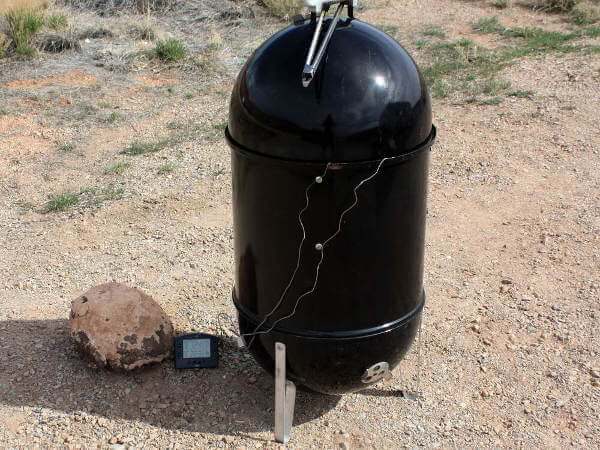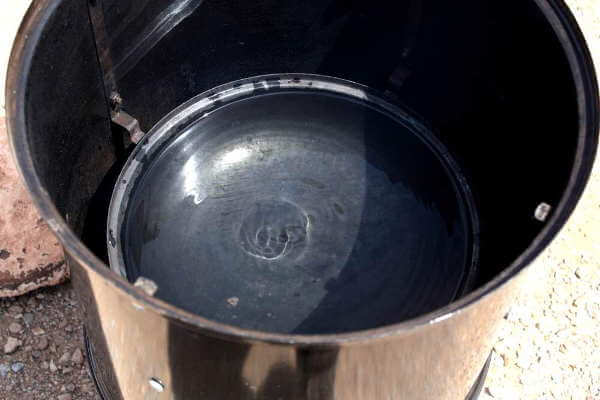Versatile Vertical Water Smokers
All vertical water smokers, whether electric, gas, or charcoal, have a pan of liquid…water with seasonings, beer, wine, soda pop…positioned between the heat and the meat. The liquid slowly evaporates during the smoking process, adding to the flavor of the food while maintaining its moistness.
 CHARCOAL WATER SMOKER
CHARCOAL WATER SMOKERThe water vapor combines with the smoke, which helps the smokiness penetrate deeper into the meat you're cooking. The humid environment inside the smoker helps keep the meat from drying out.
The water pan also catches the drippings from the meat, keeping them off of the heating element, and adding aroma to the evaporating liquid.
Vertical Smoker Heat Sources
Vertical water smokers use either electricity, charcoal, or gas as a source of heat. Gas water smokers provide for good temperature control and are easy to use. Gas smokers are also relatively portable, since the fuel source can travel with them.
Electric smokers are also easy to use. Some do not have a temperature control…some do. And portability can be a problem. You must have an electrical outlet to use them.
Charcoal smokers take a bit more effort and knowledge to use effectively. Maintaining a constant desirable temperature can be an effort. However they are usually less expensive to purchase, and are very portable, with no fuel tank or electrical outlet required.
Electric Water Smokers
 AN ELECTRIC SMOKER
AN ELECTRIC SMOKERThe best quality of electric vertical water smokers is that they are convenient. No fire or fuel issues to worry about. Pay your electric bill on time and you'll be OK.
Electric smokers may or may not have an adjustment for temperature. This usually isn't a problem. If the water pan is kept full, the smoker temperature will usually stay at or below 220 degrees. In hot weather, adding ice to the water pan will do the trick.
To monitor the temperature inside the smoker, an indicator of some kind is helpful. Some show "Low-Medium-High" on the dial, while other indicators are marked in degrees. You should verify the accuracy of the installed gauge with a good kitchen or oven thermometer.
Gas Water Smokers
 GAS SMOKER WITH ONE-PIECE WATER AND WOODCHIP PAN
GAS SMOKER WITH ONE-PIECE WATER AND WOODCHIP PANGas smokers are great at maintaining a constant desirable temperature. Most come with a cast iron chip box for your smoking wood, which sits directly over the burner.
A large door allows for easy access to the smoking meat, but also lets out a lot of heat when opened. The gas fire quickly brings the cooking compartment back up to temperature.
The Flame
Don't worry about gas affecting the flavor of the food you're smoking. A clean burning gas flame produces only carbon dioxide and water vapor as by products.
A clean gas flame is blue, or blue with a small amount of yellow. If the flame is mostly yellow or orange, you need to clean or replace the burner.
The Fuel
You should have two propane tanks on hand. Keep a full one around so you can switch tanks without having to take a trip to the store…if a store is open.
Lots of smoking is done on holidays, and if you run out and stores are closed, you are out of luck. Your smoked food will become plain old oven baked fare.
Some gas smokers are designed to burn natural gas. These require an outdoor gas line placed in the spot that your smoker will be permanently located.
There's no portability with a natural gas smoker. But then, you don't have to worry about running out of gas, either. And natural gas is less expensive than propane gas.
Charcoal Water Smokers
 WATER PAN IS FILLED IN THIS WEBER SMOKY MOUNTAIN
WATER PAN IS FILLED IN THIS WEBER SMOKY MOUNTAINCharcoal water smokers, on one hand, require a bit more knowledge, and are not quite as easy to use as gas or electric vertical water smokers.
On the other hand, charcoal smokers are sometimes less expensive and more portable than gas or electric smokers. However, high quality charcoal water smokers like the Weber Smoky Mountain are rather expensive.
Fueling the Charcoal Fire
Temperature control is the challenge of charcoal water smokers. Several factors affect the smoker temperature…brand of and amount of charcoal used, how the charcoal is arranged, outdoor temperature and wind. You can light all the charcoal at one time, and then add more at intervals throughout the smoking process.

Another method is to fill the pan with unlit charcoal, then add a layer of burning briquettes to the top. The fire will slowly work its way down through the pan of charcoal. You can mix chunks of wood into the charcoal so it will smoke as the charcoal burns.
Vertical Water Smokers
Try to keep your vertical water smoker clean and dry between uses. My first one rusted out after two years because I left it outside and uncovered. I didn't disassemble the sections to let the interior dry after each smoking session.
Buy one with a temperature gauge, or install one yourself. It's important to know the temperature of your smoker.
Some are built with dual-wall construction. This adds to the smoker's efficiency while keeping the exterior cooler and safer.
Ease of use, portability, fuel choice, affordability, and efficiency. These are the factors that come into play when choosing a vertical water smoker. Buy the highest quality you can afford, and realize that cheapest is not necessarily the lowest quality.
Shop smartly at good stores, asking a lot of questions. Decide on the model you want, then find the lowest price on that model.
You usually get what you pay for. Look for good, solid construction. Good quality welds, thicker metals, tight fitting doors with solid latches and hinges, stable and not shaky when set up…these are the outward signs of a good smoker.
Stay away from thin sheet metal construction and sloppy workmanship if you can afford to. The cheap, lightweight smokers will warp, rust out, and fall apart quickly.
Get a cheap vertical water smoker if it's all you can afford. Take good care of it. Keep it dry and clean and coated with oil to prevent rust. Keep it out of the weather, and be gentle with it. Do these things and you should get a few good years out of a bargain priced, low quality smoker.
Heavier, thicker metals hold and retain heat better, giving you more stable, consistent and efficient heating. The heavier construction also holds up better over time, giving you many more years of use.
- You Are Here: Home >
- Meat Smokers >
- Vertical Water Smokers
